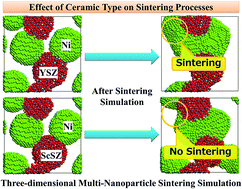Multi-nanoparticle model simulations of the porosity effect on sintering processes in Ni/YSZ and Ni/ScSZ by the molecular dynamics method†
Abstract
Understanding the sintering mechanism in porous anodes is necessary for developing durable anodes suitable for use in solid oxide fuel cells. A multi-nanoparticle sintering simulation method based on molecular dynamics (MD) calculation was developed for this purpose [J. Xu et al., J. Phys. Chem. C, 2013, 117, 9663–9672]. The method can be used to calculate the effect of the porous structure properties, such as the porosity and framework structure, on the sintering, unlike previous sintering simulations with conventional nanoparticle models. We revealed that, in a Ni/YSZ porous anode, the YSZ nanoparticle framework suppresses sintering of Ni nanoparticles by disrupting the growth of the neck between two Ni nanoparticles. In this paper, we used our method to reveal the effect of ceramic type on the sintering processes. We investigated the difference between the sintering and degradation processes in Ni/YSZ and Ni/ScSZ anodes. In the simulation, the degree of sintering of the Ni nanoparticles in Ni/ScSZ was smaller than that in Ni/YSZ. The stronger adhesion of Ni to ScSZ nanoparticles than to YSZ nanoparticles prevented the Ni nanoparticles from approaching each other in the Ni/ScSZ anode, inhibiting sintering. Our multi-nanoparticle sintering MD simulations revealed the different sintering processes for Ni nanoparticles in Ni/YSZ and Ni/ScSZ anodes. We also investigated the effect of sintering on degradation. The hydrogen adsorption sites and electrochemical reaction sites of the hydrogen oxidation decreased as the degree of sintering increased. A low degradation of the Ni/ScSZ anode relative to that of the Ni/YSZ anode was observed. Furthermore, we showed the effect of porosity on degradation induced by sintering in Ni/YSZ and Ni/ScSZ, and found an optimal porosity. These findings cannot be obtained by conventional two- or three-nanoparticle sintering MD simulations. Our multi-nanoparticle sintering simulation method is useful for revealing the types of ceramics suitable for inhibiting sintering and degradation in anodes, and can be used to design durable anodes.


 Please wait while we load your content...
Please wait while we load your content...